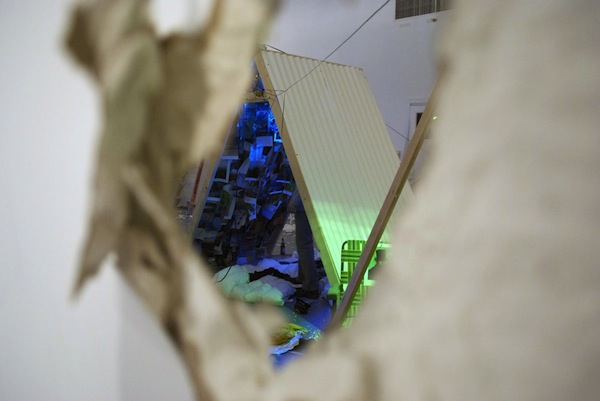Senior Studio Duo Turn One Room into Two Collections

A Surprised senior studio audience got a second helping of The Collection when the artists’ orchestrated a small demolition project.
April 20, 2012
It is not unusual for artists to alter familiar spaces dramatically as part of their projects, but rarely is this transformation as extreme as last week’s Senior Studio Show, The Collection, which appropriately fell on Friday the 13th. The Collection represented the collaboration of College seniors Chase Stone and Gregory Wikstrom, and the two integrated their aesthetic vocabularies so fluidly that distinguishing between their contributions was impossible. Indeed, Stone commented, “I found that Gregory and I were able to amalgamate our skills into a cohesive project. We made each other better artists because of our process.”
Stone and Wikstrom literally reinvented the space of Fisher Gallery, separating it into two rooms through the construction of a temporary wall. They likewise obstructed one of the entrances with a false wall that both disoriented our interaction with the familiar space and re-routed our movements.
Behind the obstructed entrance, in the space fabricated for the show, a phone sat on a desk along with a computer keyboard. A plaque removed from the far side of Fisher was re-hung, jarringly, alongside a clock and decoy camera that connected to a feed projecting the video onto a screen inside the first room inside of the gallery.
Whispers of “an expansion” drew a curious audience to the show early on, and, around 8:30 p.m. College senior Daniel Dudley broke a hole through the wall with a hammer, allowing viewers to enter the second room for the first time.
The first room contained tables with various disassembled artifacts like old cameras, projectors, dismantled typewriters, photos and projected images on the walls. All of the objects found in the first room are a part of The Collection. Along the northern wall, Stone and Wikstrom sequestered a bench with three TV screens playing a live feed of the people in the second room. Cameras were placed in various corners of the room, allowing people to see what was happening everywhere in Fisher Gallery, except of course the room they were in.
In the second room Stone and Wikstrom constructed a corrugated zinc tent with bedding and blue light inside of it. The interior walls of the tent were littered by post-its and nonsensical rhetorical fragments, while its exterior was surrounded by a chaotic display of papers and other disparate collected items like tape decks and recorders. In one corner of the second room stood four television screens projecting footage from the cameras in the first room. Alongside the screens, posters of cars and Fabio-esque musclemen adorned the white walls.
Stone explained, “The concept behind our project arose from walking down the street. We observed little moments, pockets of space that were closed off, thus inviting our eyes to explore them. Personally, I was very inspired by Everyman’s Infinite Art, an exhibition at Chapman University in the 1960s. [Ilya] Kabakov’s work in Marfa was also a mutual inspiration.”
In December, at the Senior Studio Halftime show, the duo installed a single room with a screen showing a live feed from a camera placed outside of it, and the pieces that make up the collection show clear development from this early conception.
The explicit theme seen throughout Stone and Wikstrom’s project is surveillance. The Collection explores the omnipresence of surveillance in our everyday world. In their artists’ statement, Stone and Wikstrom claim, “Security objects affect our perception of public and private space, whether or not we are aware.”
The show forces viewers to interact with what they are seeing because they become an integral part of what is presented through the cameras filming almost all parts inside of the gallery.
The artists’ statement explains, “We created a space that would embody the ambiguous dialogical relationship between observer and observed, mechanized security processes and the organic humanexperiences machines attempt to facilitate.”
Stone commented, “I was satisfied [with the show] because I felt a strong critical engagement. People came up to me to after the show to discuss the way they felt in the space.”

























